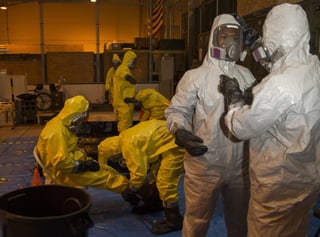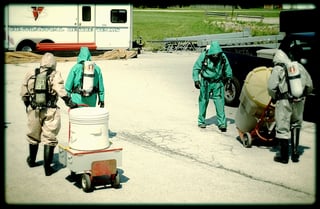1910.120(e)(6) Qualifications for trainers. Trainers shall be qualified to instruct employees about the subject matter that is being presented in training. Such trainers shall have satisfactorily completed a training program for teaching the subjects they are expected to teach, or they shall have the academic credentials and instructional experience necessary for teaching the subjects. Instructors shall demonstrate competent instructional skills and knowledge of the applicable subject matter.
So, this hopefully clears up the question, right? However, this statement doesn’t prevent a subject matter expert who may have not completed the 40-hour HAZWOPER class from teaching a portion of the class. To answer the question at the start of this post, the safety person who didn’t attend the course could certainly teach something within the realm of HAZWOPER if they completed a training program for the subjects, have academic credentials and instructional experience. They must be competent in what they are teaching the students.
Further in the standard it speaks specifically to refresher training 1910.120(e)(8) which, very basically, restates the requirements of the initial class and that they should be met in the refresher training. 1910.120(q)(8)(i) also states employees shall receive annual refresher training of sufficient content and duration to maintain their competencies, or shall demonstrate competency in those areas at least yearly.
 According to 1910.120(e)(8) you should be covering the following:
According to 1910.120(e)(8) you should be covering the following:
- Names of personnel and alternates responsible for site safety and health
- Safety, health, and other hazards present on the site
- Use of personal protective equipment (PPE)
- Work practices by which the employee can minimize risks from hazards
- Safe use of engineering controls and equipment on the site
- Medical surveillance requirements including recognition of symptoms and signs which might indicate over exposure to hazards
- Site safety and health plan
- Any critique of incidents that have occurred in the past year that can serve as training examples of related work, and other relevant topics
If your HAZWOPER refresher instructor is capable of providing this instruction and meets the other requirements for a “qualified trainer,” they certainly can teach. What the concern might be is that someone who has no training in a fully encapsulating protective suit is now teaching a group of people who must be competently trained and refreshed annually to do so – following the standard this person would not be authorized to teach this section, though could be qualified in other areas.
Throughout the OSHA standard there are various exceptions and alternate conditions for training [1910.120(e)(9)], new employees [1910.120(p)(7)], and employees who have received HAZWOPER training previously but are new to the site [1910.120(e)(9)].
This may have helped you determine who can teach your training. Certainly, if you have any questions regarding any aspect of HAZWOPER training please reach out to us, we’d be happy to walk through our process or your process and needs with you.


 What about spills? What is your plan when the drums start leaking or the forklift driver pierces a tote? A bulk delivery driver is delivering a tanker full of hazardous materials to your site storage tanks, now the trailer is leaking, what can you do?
What about spills? What is your plan when the drums start leaking or the forklift driver pierces a tote? A bulk delivery driver is delivering a tanker full of hazardous materials to your site storage tanks, now the trailer is leaking, what can you do? for your site and equipment. There is no universal expiration date for hazmat response equipment and each piece of equipment is different. At all times manufacturer guidelines should be followed.
for your site and equipment. There is no universal expiration date for hazmat response equipment and each piece of equipment is different. At all times manufacturer guidelines should be followed.